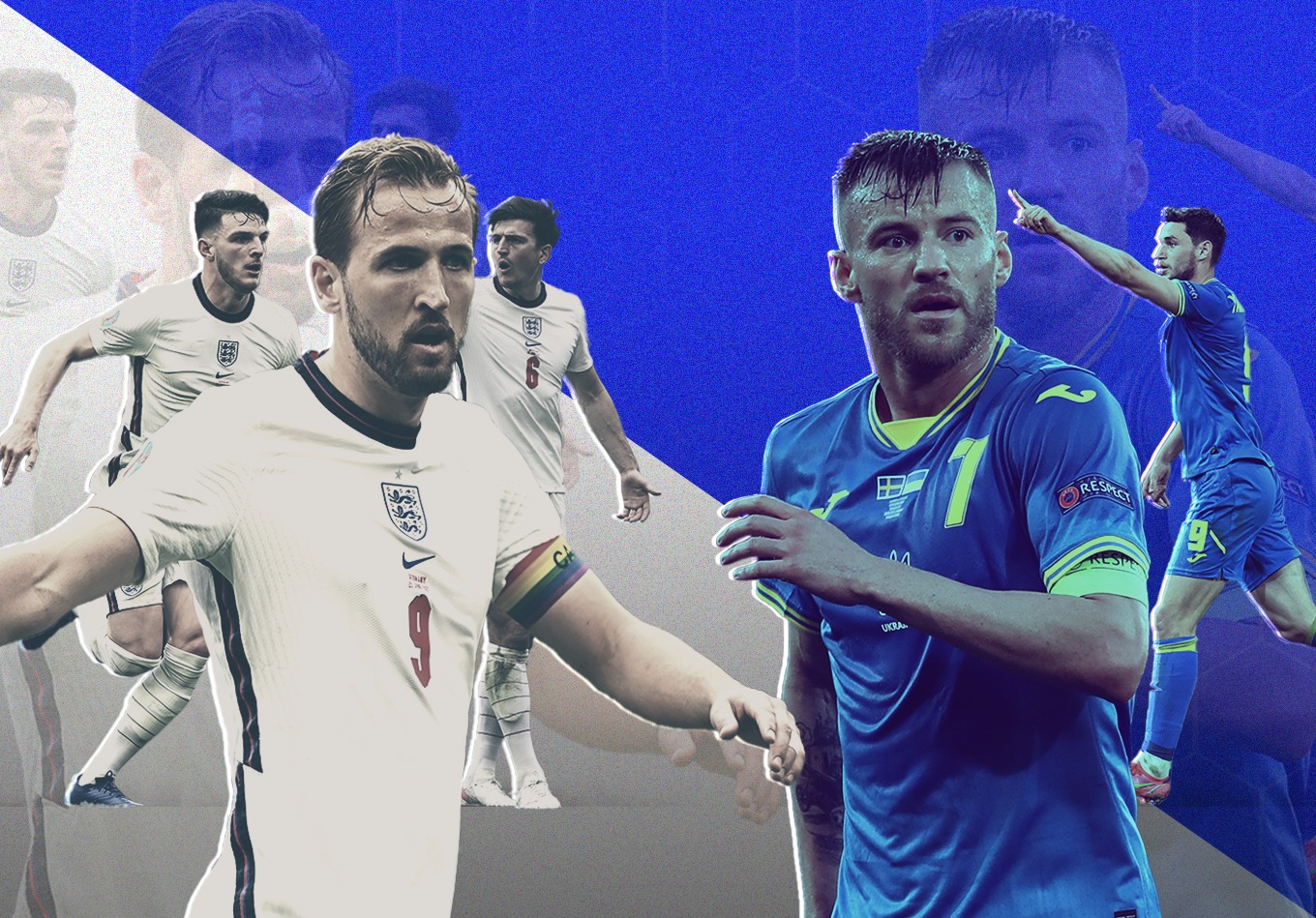After Tuesday’s monumental win over Germany, all eyes turn to Rome as England prepare to take on Ukraine. Here are five key tactical trends to look out for as the sides do battle.
1. Harry Maguire’s Ability to Carry the Ball out of Defence Will Be Crucial
Harry Maguire has been immense for England since he returned from injury in England’s final group game against the Czech Republic. While Tyrone Mings deputised ably in his absence, Maguire’s return adds an extra dimension to England’s back line. Yes, Maguire is fantastic in the air. He’s an absolute bully, winning 75% of his aerial duels in the Premier League last season, which was more than any outfielder. And at Euro 2020 he’s not lost a single header yet.
But where Maguire really adds something different is in England’s build-up play, with his ability to carry the ball out from defence. As Maguire’s carry map below shows, he is frequently required to step out from defence and progress the ball over halfway.
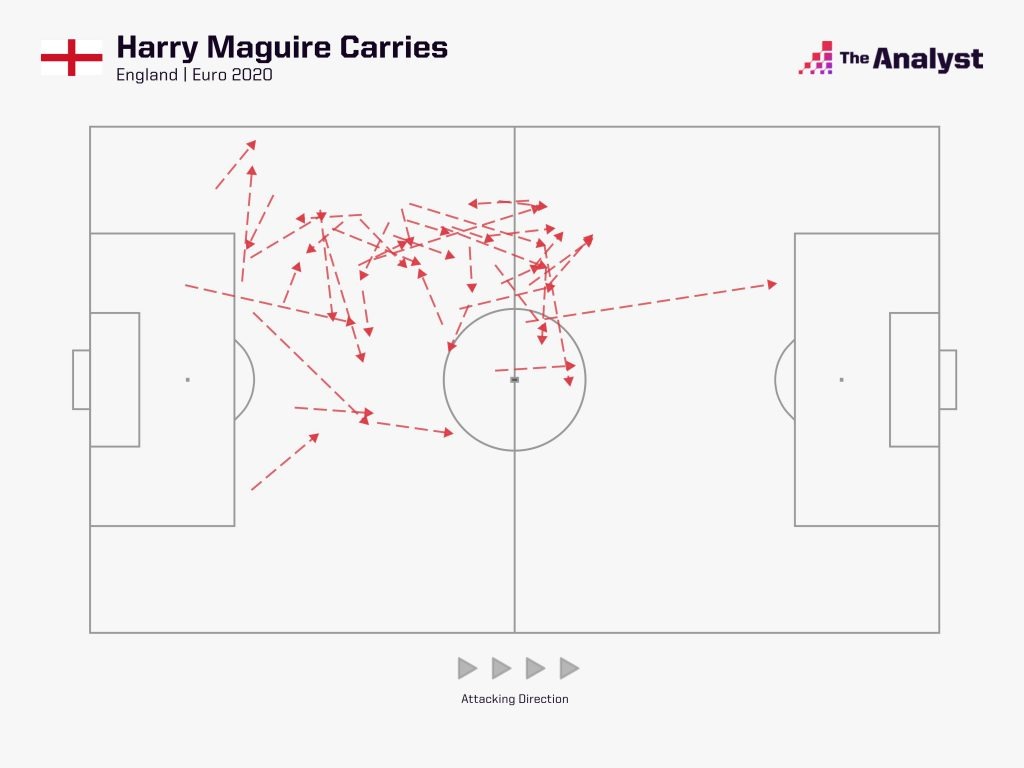
Maguire, together with partner John Stones, has been crucial in getting England up the pitch. Maguire ranks first (11.5), and Stones third (8.5), of England players for progressive carries per 90 minutes – essentially how many times a player carries the ball more than five metres toward the opposition goal. The pair are also England’s most direct ball carriers too, carrying the ball straight towards the opposition goal 20% of the time. For comparison, England’s two deep-lying midfielders, Declan Rice (10%) and Kalvin Phillips (3%), aren’t nearly as direct with their dribbling. This is in stark contrast with sides like Italy and Germany, who have used the likes of Jorginho and Toni Kroos to act as their prime ball progressors.
Ukraine will most likely sit deep against England and force them to prize them open. Of all of the teams left in the tournament, Ukraine start their passages of play the closest to their own goal, suggesting they are comfortable sitting deep and building attacks from deep.
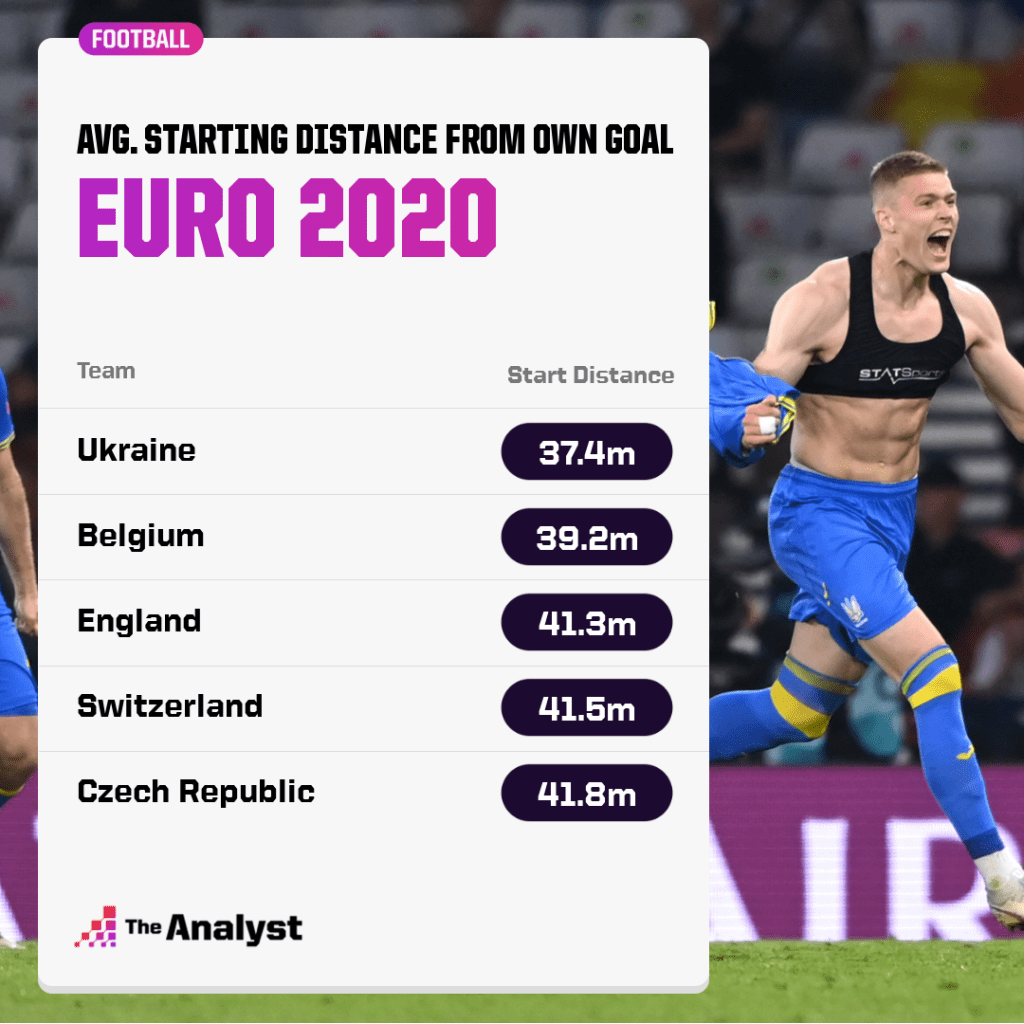
This will afford Maguire and Stones the space to carry the ball into, and they’ll need to be bold and assertive with those runs to kickstart England’s attacks.
2. Harry Kane’s Influence Is More Than Just as a Goalscorer
The Premier League’s top goalscorer with 23 goals last season and a man with 45 goals scored in 63 games at Wembley across his career is coming in for criticism. What has happened during Euro 2020 for the footballing world to have questioned Southgate’s decision to continue starting Harry Kane?
When we think about Kane, we think of high shot rate and high shot conversion. Those have been the hallmarks of his game for years, but during Euro 2020 so far, Kane is a long way down the list of total shots taken, with just six. That puts him alongside wing-backs like the Netherlands’ Denzel Dumfries and Italy’s Leonardo Spinazzola.
Shot Leaders at Euro 2020:
| Rank | Player | Shots | Shots on Target | Goals | Expected Goals |
|---|---|---|---|---|---|
| 1 | Alvaro Morata | 16 | 7 | 2 | 3.16 |
| 2 | Kylian Mbappe | 14 | 3 | 0 | 2.02 |
| 3 = | Emil Forsberg | 13 | 4 | 3 | 0.99 |
| 3 = | Martin Braithwaite | 13 | 3 | 1 | 1.37 |
| 10 = | Harry Kane | 6 | 2 | 1 | 1.87 |
Despite his low shot count, Kane has still managed to accumulate a total expected goals value of 1.87, which sees him within the top 10 players of the tournaments, tied alongside Georginio Wijnaldum. Unfortunately for Kane and England, he has only netted once, despite him having five big chances to score.
Looking at where Kane stacks up in the ‘Shooting Goals Added’ metric, which takes the player’s shot placement (xGOT) and takes away the quality of the chance (xG) we see that Kane’s total is -0.69. Put simply, the placement of his shots have been below average given the quality of the chances he’s had. So people are rightfully starting to question his finishing at the tournament.
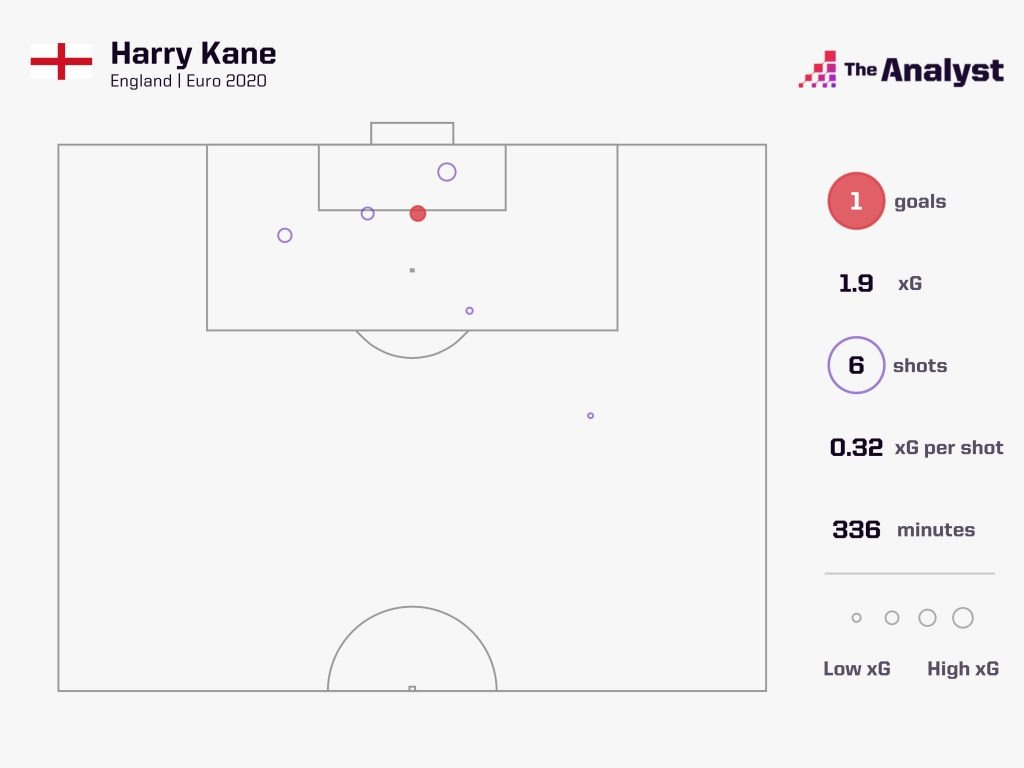
A huge emphasis is put on centre forwards to put the ball in the back of the net and understandably so. And with Kane averaging one of the worst minutes-per-goal of any striker at the Euros (336 mins) and seemingly a shadow of his usual self, some of the criticism he has faced could be called fair. However, if we look beyond his poor end-product, do people’s opinions need to change on his involvement in Southgate’s team selection?
Believe it or not, and sometimes it’s difficult to reconcile this with what our eyes are telling us, but whenever England threaten Kane is very much still involved. Shots at goal have been a rare commodity for this England side so far, but only Raheem Sterling (14) has been involved in more open play sequences that have ended in a shot than Kane’s 10. The England captain has been involved in sequences worth 3.6 xG in total, again only bettered by Sterling at 4.5.
Does Southgate continue to persist with his captain in the quarter-finals against Ukraine? Of course, he does.
3. England Will Need to Move the Ball Faster to Break Down Ukraine
England are going to need to be better at generating chances if they are to break down Ukraine on Saturday. Southgate’s side are averaging more shots against than for per game, ranking third-worst with 6.8 for shots taken – almost half the tournament average of 12.1 – and nowhere near their Euro 2020 qualification average of 14.4.
If we flick through the big dictionary of sporting cliches we’ll find “attack is the best form of defence”. This certainly came to light in England’s qualifying campaign with them managing to win possession back high up the pitch (within 40 metres of the opposition’s goal) 8.4 times per game. So, have England changed the frequency of their high press? Not really. In the four games played, there has been a slight drop off in the numbers but nothing major, with regains now occurring one fewer time per game. But what has changed is converting these high turnovers into chances.
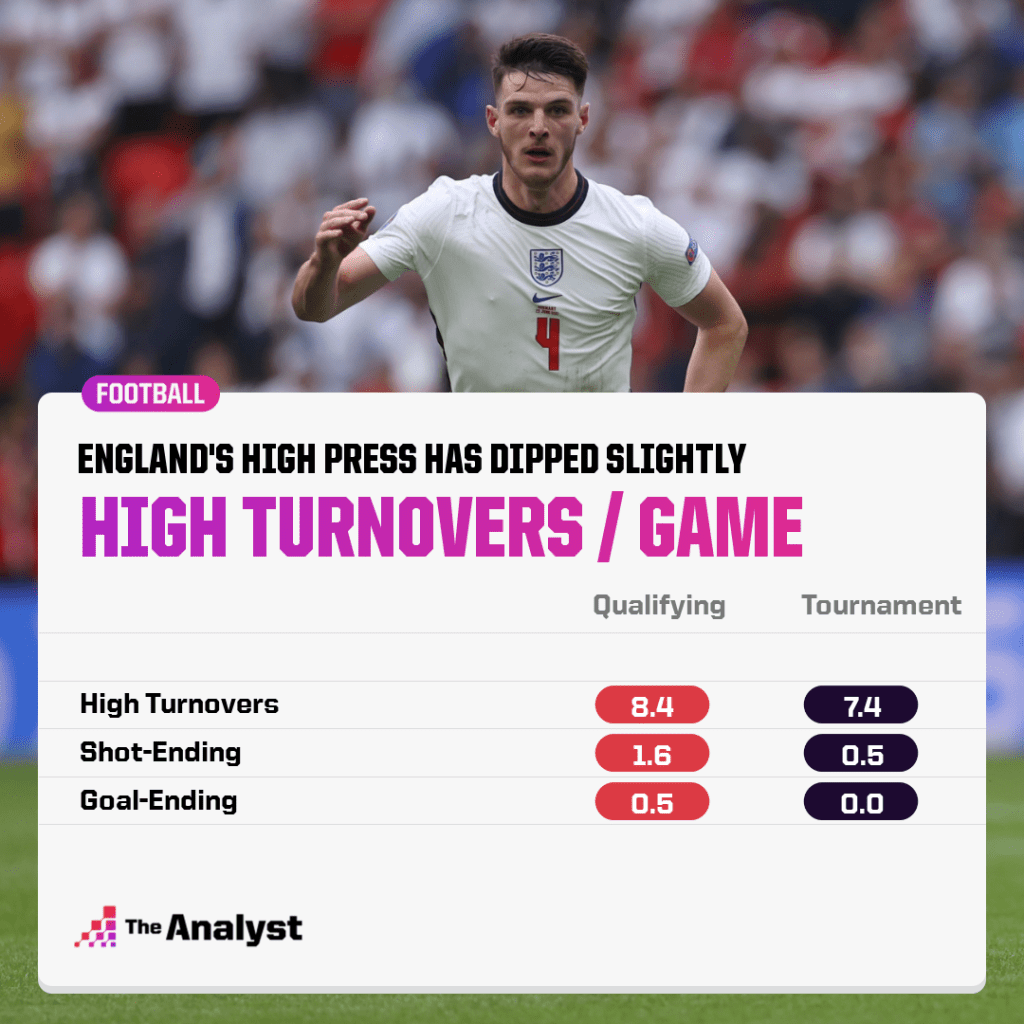
The regains are still occurring roughly around the same locations too, though the key difference between qualifying and now is the speed at which the opposition’s goal is then attacked once possession is regained. When a team wins possession high up the pitch, it means there is less distance to travel to the opposition’s goal. High turnovers often occur from misplaced passes due to an unforced or forced error from the defensive pressure applied.
One way attacking teams can capitalise on a turnover is by a combination of attempting to outnumber the opposition whilst attacking at speed. England managed to successfully do just that during their qualifying campaign but have slowed down their speed after regains and increased their number of passes at Euro 2020.
England’s Speed During Attacks:
| Stage | Direct Speed Before Shooting | Avg. # of Passes on Shot-Ending Sequences |
|---|---|---|
| Qualifying | 1.7 | 5.9 |
| Tournament | 1.2 | 7.1 |
The Three Lions’ style hasn’t been easy on the eye, with many labelling them ponderous and slow. That feeling is borne out in the numbers, too. Southgate’s side have made, on average, the sixth most passes per sequence (4.4), but progress upfield the slowest of any team (0.9 m/s).
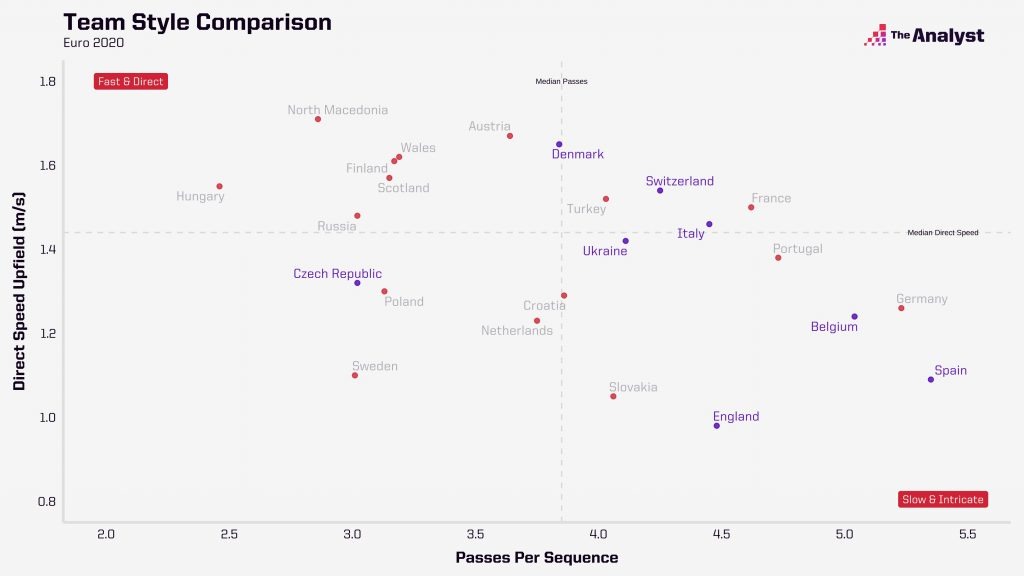
A likely way the game plays out on Saturday is that Ukraine defend deep, inviting England to try and break them down. If the current competition has been evident of something, it is that England have struggled to create a lot of chances. They’ll need to play faster and with more tempo on Saturday, something that may influence Southgate’s team selection in Rome.
4. Ukraine Will Look to Cause Danger Down England’s Left
Ukraine have scored two more goals than England so far and have taken 44 shots to England’s 27, all whilst averaging just under 50% possession across their tournament so far. With both teams not having truly dominated a game so far, the match seems destined to see one side to take control whilst the other tries to hurt them in transition.
How can Ukraine hurt England? The first question is whether Southgate chooses to switch back to a back four or sticks with the back five that he opted for versus Germany.
If he does stick with a similar setup to the previous knockout game with wing backs, England will likely dominate possession. Here, Ukraine’s usual phases of play could hurt England.
Throughout the tournament, West Ham’s Andriy Yarmolenko has been their main dangerman according to our Expected Possession Value (xPV) model, which looks at a player’s contribution to increasing their team’s likelihood of scoring a goal. Yarmolenko has contributed to 0.34 xPV, which is similar to Denmark’s standout player, Mikkel Damsgaard (0.33). The attacking wide dribbler has been hurting teams with a mixture of his direct dribbling and progressive passing down Ukraine’s right-wing.
Continuing on the theme of xPV, Ukraine’s most threatening possessions come down their right-hand, mainly as a result of some of Yarmolenko’s great work.
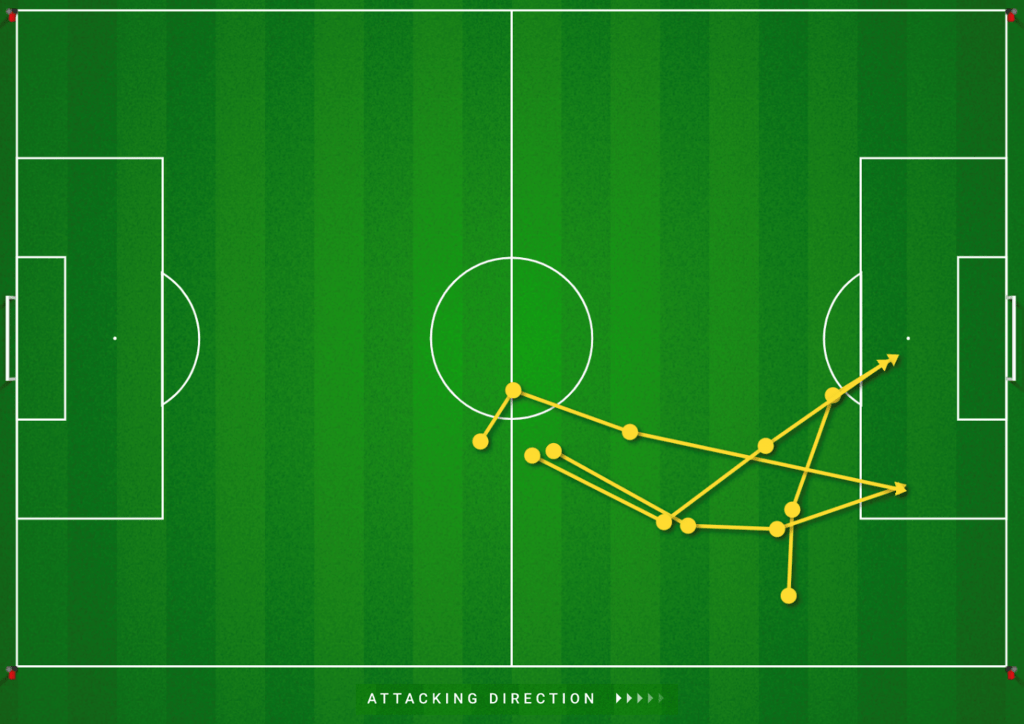
Shown above are four examples of Ukraine’s most dangerous attacking patterns. Each contain multiple individual chains of possessions (shown below), which are combined to create these overall patterns.
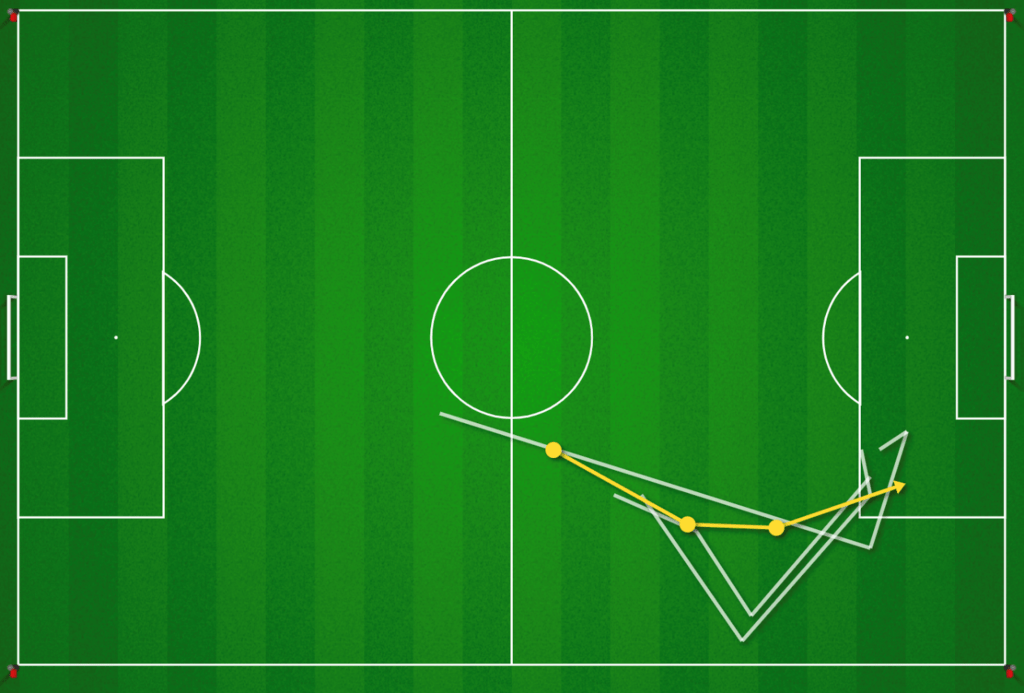
We can analyse their goal against North Macedonia as a prime example. This is where the space left by England’s left wing-back and left centre-back could cause them issues and could be Ukraine’s strategy for victory.
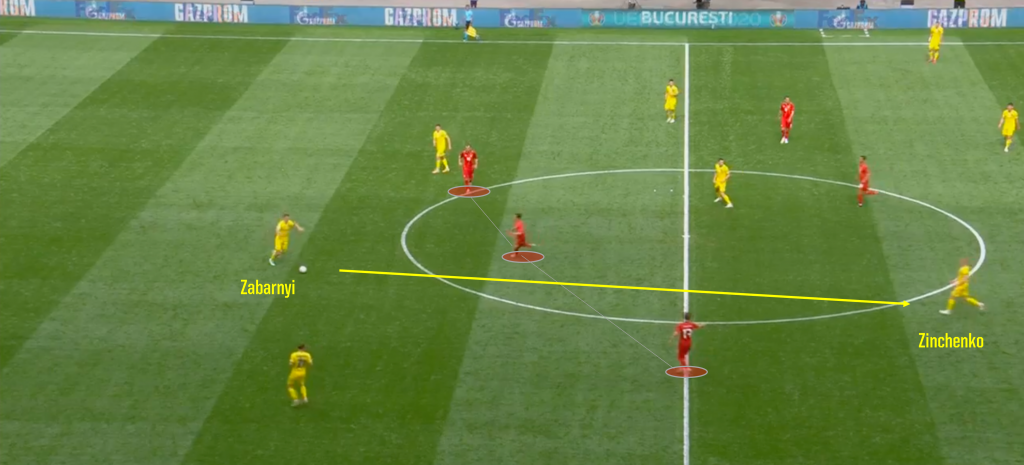
Following a recycle of possession around Ukraine’s defensive line, Oleksandr Zinchenko comes deep to receive the ball from Illia Zabarnyi after North Macedonia apply a three-man press. Checking his shoulders and scanning as the ball travels, Zinchenko receives possession on the half-turn and in three touches he plays a pass to the right wing to Yarmolenko.
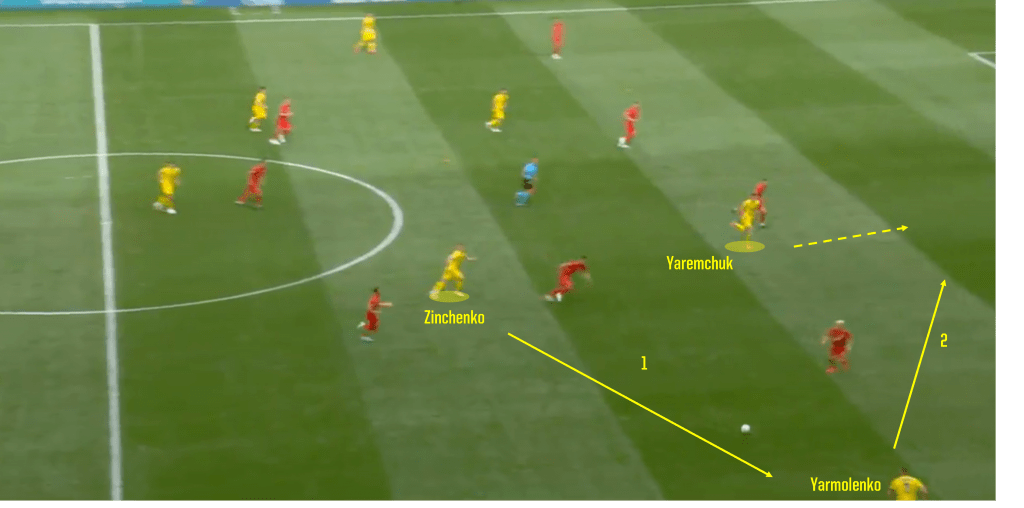
Yarmolenko then plays a first time pass in behind Alioski and North Macedonia’s defence which puts Roman Yaremchuk – who bends his run to stay onside – through on goal to score his second goal of the tournament. If Ukraine are to become the first team to score against England in the tournament it’s likely to come from this sort of play on their right flank.
5. England Looking for Raheem Sterling From Throw-in Routines
As we outlined in more detail earlier in the tournament, Southgate and England have got creative with their throw-in routines this summer. Particularly with the aim of getting Raheem Sterling, their most influential player thus far, on the ball in dangerous central areas. This tactic was again on show against Germany.
One example came in the 13th minute. As they did against Croatia in their opening game, five England players start very close to the touchline, drawing in five German players who are forced to man mark them. This opens up a big hole in the middle of midfield for Sterling to receive the pass.
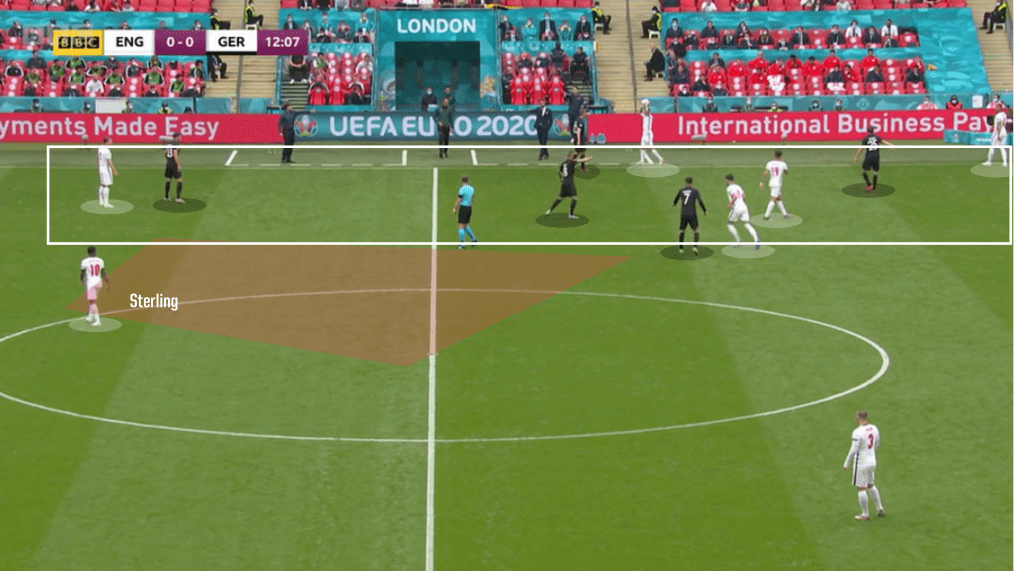
Trippier is alert to the gap and fires the ball at Sterling. He actually throws it before Sterling motions towards him, almost forcing the England forward to come and get it. Kimmich, who was marking Sterling is forced to track his run inside. Just look how narrow the German back three plus Kimmich is. You could throw a blanket over them.
The knock-on effect of this is the space that’s now opened up behind Kimmich for Luke Shaw to bomb into. You can see him starting to go…
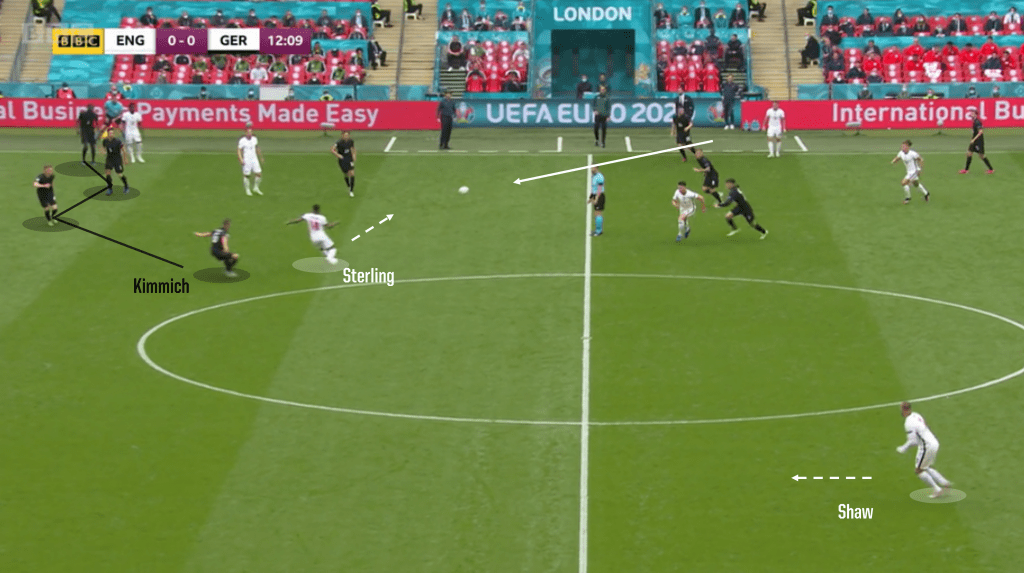
Sterling receives the pass, turns and then squares up Leon Goretzka who does well to apply pressure to Sterling. Faced by Goretzka, he turns back on himself, keeping possession but the momentum is lost. Had he looked up he would’ve seen Shaw in all sorts of space to his left, basically in on goal.
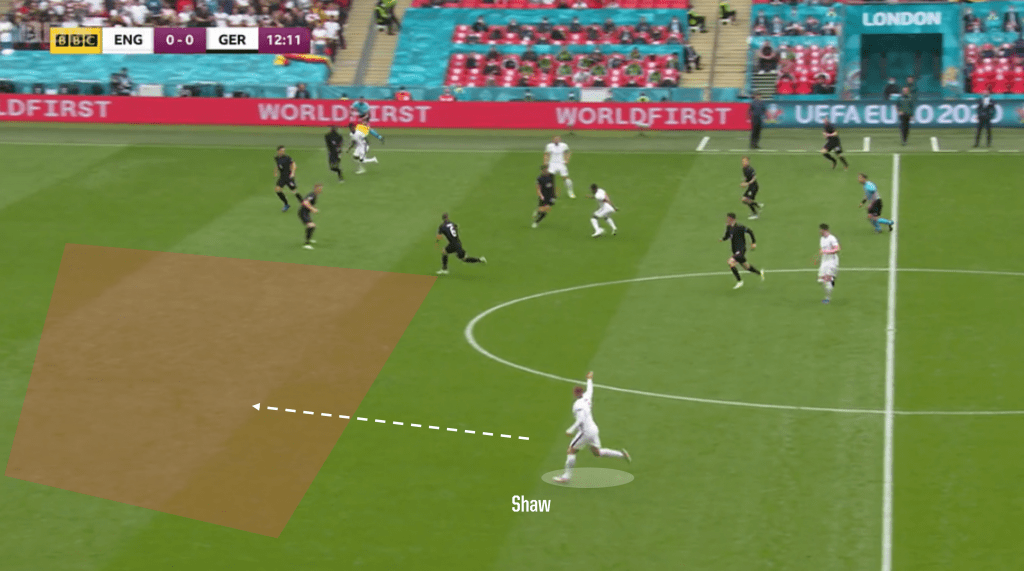
Southgate and his coaching team look to extract every margin they can. This is yet another way of doing that.
Enjoy this? Subscribe to receive weekly exclusive content.
Design by Briggs Clinard.
